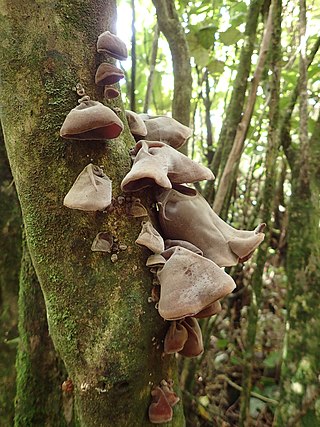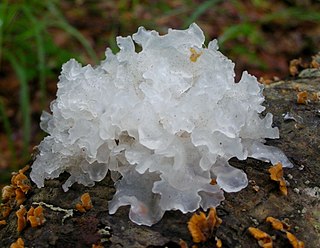
The Polyporales are an order of about 1800 species of fungi in the division Basidiomycota. The order includes some polypores as well as many corticioid fungi and a few agarics. Many species within the order are saprotrophic, most of them wood-rotters. Some genera, such as Ganoderma and Fomes, contain species that attack living tissues and then continue to degrade the wood of their dead hosts. Those of economic importance include several important pathogens of trees and a few species that cause damage by rotting structural timber. Some of the Polyporales are commercially cultivated and marketed for use as food items or in traditional Chinese medicine.

Polypores are a group of fungi that form large fruiting bodies with pores or tubes on the underside. They are a morphological group of basidiomycetes-like gilled mushrooms and hydnoid fungi, and not all polypores are closely related to each other. Polypores are also called bracket fungi or shelf fungi, and they characteristically produce woody, shelf- or bracket-shaped or occasionally circular fruiting bodies that are called conks.

Auricularia cornea is a species of fungus in the order Auriculariales. It is commercially cultivated for food in China. The species was previously referred to Auricularia polytricha, but the latter species is probably a later synonym. Auricularia cornea is a popular ingredient in many Chinese dishes and is also used in traditional Chinese medicine.

Lingzhi, Ganoderma sichuanense, also known as reishi or Ganoderma lingzhi is a polypore fungus native to East Asia belonging to the genus Ganoderma.

Tremella fuciformis is a species of fungus; it produces white, frond-like, gelatinous basidiocarps. It is widespread, especially in the tropics, where it can be found on the dead branches of broadleaf trees. This fungus is commercially cultivated and is one of the most popular fungi in the cuisine and medicine of China. T. fuciformis is commonly known as snow fungus, snow ear, silver ear fungus, white jelly mushroom, and white cloud ears.

Cinnamomum is a genus of evergreen aromatic trees and shrubs belonging to the laurel family, Lauraceae. The species of Cinnamomum have aromatic oils in their leaves and bark. The genus contains approximately 250 species, distributed in tropical and subtropical regions of South Asia, Southeast Asia, East Asia and Oceania/Australasia. The genus includes a great number of economically important trees used to produce the spice of cinnamon.

Phallus indusiatus, commonly called the bamboo mushrooms, bamboo pith, long net stinkhorn, crinoline stinkhorn, bridal veil, or veiled lady, is a fungus in the family Phallaceae, or stinkhorns. It has a cosmopolitan distribution in tropical areas, and is found in southern Asia, Africa, the Americas, and Australia, where it grows in woodlands and gardens in rich soil and well-rotted woody material. The fruit body of the fungus is characterised by a conical to bell-shaped cap on a stalk and a delicate lacy "skirt", or indusium, that hangs from beneath the cap and reaches nearly to the ground. First described scientifically in 1798 by French botanist Étienne Pierre Ventenat, the species has often been referred to a separate genus Dictyophora along with other Phallus species featuring an indusium. P. indusiatus can be distinguished from other similar species by differences in distribution, size, color, and indusium length.

Quercus variabilis, the Chinese cork oak, is a species of oak in the section Quercus sect. Cerris, native to a wide area of eastern Asia in southern, central, and eastern China, Taiwan, Japan, and Korea.

Ganoderma applanatum is a bracket fungus with a cosmopolitan distribution.

Ganoderma is a genus of polypore fungi in the family Ganodermataceae that includes about 80 species, many from tropical regions. They have a high genetic diversity and are used in traditional Asian medicines. Ganoderma can be differentiated from other polypores because they have a double-walled basidiospore. They may be called shelf mushrooms or bracket fungi.

Antrodia is a genus of fungi in the family Fomitopsidaceae. Antrodia species have fruit bodies that typically resupinate, with the hymenium exposed to the outside; the edges may be turned so as to form narrow brackets. Most species are found in temperate and boreal forests, and cause brown rot.

The flora of China consists of a diverse range of plant species including over 39,000 vascular plants, 27,000 species of fungi and 3000 species of bryophytes. More than 30,000 plant species are native to China, representing nearly one-eighth of the world's total plant species, including thousands found nowhere else on Earth. China's land, extending over 9.6 million km, contains a variety of ecosystems and climates for plants to grow in. Some of the main climates include shores, tropical and subtropical forests, deserts, elevated plateaus and mountains. The events of the continental drift and early Paleozoic Caledonian movement also play a part in creating climatic and geographical diversity resulting in high levels of endemic vascular flora. These landscapes provide different ecosystems and climates for plants to grow in, creating a wide variety of different flora spanning over not just China, but different parts of the world.

Zhankuic acids are sterols isolated from the fungus Taiwanofungus camphoratus. Zhankuic acid C possesses in vitro anti-inflammatory properties due to its role as a selective TLR4/MD-2 antagonist.
In Chinese mythology and folklore, Feng was an edible monster that resembles a two-eyed lump of meat and magically grows back as fast as it is eaten. Early Chinese texts also referred to this legendary food with the names Shìròu, Ròuzhī, and Tàisuì. Ròulíngzhī is a modern name popularized by Chinese news media reporting on purported discoveries of Feng throughout China.

Cinnamomum kanehirae, also known as small-flowered camphor tree, or stout camphor tree, is a tree within the genus Cinnamomum of the family Lauraceae endemic to Taiwan.

Taiwanofungus is a fungal genus of unknown familial placement in the order Polyporales. The genus contains two species: the type, Taiwanofungus camphoratus, and T. salmoneus. Taiwanofungus was circumscribed by Taiwanese mycologists in 2004. T. camphoratus is a medicinal fungus that is found in Taiwan, where it grows on the endemic tree species Cinnamomum kanehirae. It was first described in 1990 by Mu Zang and Ching-Hua Su as a species of Ganoderma. T. salmoneus, originally placed in Antrodia, was validly added to the genus in 2012.
Ganoderma sinense is a black to purplish-black or dark brown laccate species of Ganoderma found in China, Japan and Taiwan growing on decaying wood of broad-leaved trees and pine stumps. It is used in traditional Asian medicine, where it is known as zizhi in Chinese.
Forestry in Taiwan was historically a significant industry. The logging of most of Taiwan's old growth forest has led to the sunset of the industry with remaining stands protected by law. Illegal logging remains a significant threat, especially to the oldest and most valuable trees.

Ganoderma microsporum is a species of Ganoderma mushroom native to Taiwan that grows on willow trees.
Naematelia aurantialba is a species of fungus producing yellow, frondose, gelatinous basidiocarps parasitic on fruit bodies of another fungus, Stereum hirsutum, on broadleaf trees. In China, where it is called jīn'ěr, it is cultivated for both food and medical purposes.
















